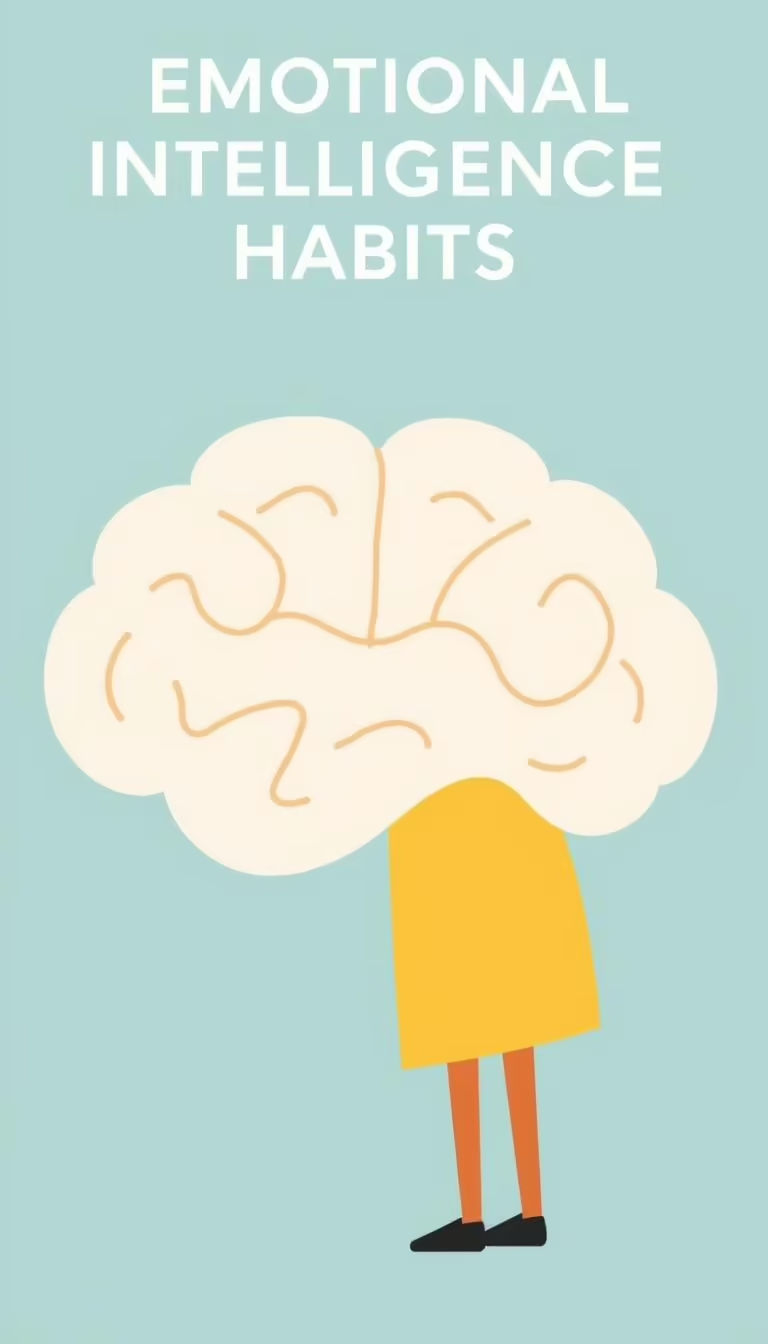Emotional Intelligence Habits: How to Build Them in 5 Steps
Table of Contents
Emotional intelligence habits help us deal with life’s ups and downs. They affect our relationships, career, and happiness. By following five simple steps, anyone can get better at handling emotions.

Today, emotional intelligence (EQ) is key in both work and personal life. Studies show EQ plays a big role in making decisions, working together, and handling stress. This article shares proven ways to build these habits, starting with knowing yourself and ending with being resilient.
Emotional intelligence habits give us tools to handle conflicts at work or in family life. They help us think before we act, instead of acting on impulse. Each step in this guide tackles real-life situations, making it easy to apply these ideas right away.
Understanding the Fundamentals of Emotional Intelligence
Emotional intelligence (EQ) is key to handling life’s ups and downs. It starts with understanding its basics. These skills help us manage our feelings every day.

The Four Pillars of EQ
EQ has four main parts:
- Self-awareness: It’s knowing and understanding our own feelings.
- Self-regulation: It’s about controlling our impulses and staying calm when stressed.
- Social awareness: It’s about noticing and feeling others’ emotions through empathy and listening.
- Relationship management: It’s using EQ to build trust and solve conflicts.
Why Emotional Intelligence Matters Today
In today’s world of remote work and constant online interaction, EQ is more important than ever. It helps us understand ourselves better in virtual settings. It also helps us stay calm and make better decisions despite the flood of information.
Companies like Google and Microsoft now see EQ as essential for leaders. They include it in their training programs. This shows EQ’s value in many different places.
The Science Behind Emotional Processing
Neuroscience tells us how EQ works in our brains. The amygdala makes us feel emotions, while the prefrontal cortex helps us think clearly. Studies show that practicing EQ strengthens the connection between these brain parts.
This connection helps us solve problems and work together better. EQ is not just about feeling emotions; it’s about using that feeling to improve our lives and work.
The Impact of Emotional Intelligence Habits on Personal Success
Emotional intelligence habits are key to success in work, relationships, and personal growth. Leaders with high EQ do better by 38% in important job areas. These skills help turn problems into chances for growth, making us more resilient and adaptable.

People with strong EQ habits earn 9% more and feel 20% less stressed. For instance, a tech company’s client satisfaction jumped 40% after teaching teams to listen actively and empathize. Such relationship management skills cut down on misunderstandings and build trust, essential in teamwork.
- EQ boosts decision-making by 60% (LinkedIn Talent Solutions, 2023).
- Teams with high EQ have 50% fewer conflicts and 30% more innovation.
Over time, emotional intelligence habits bring stability. People with high EQ have healthier personal relationships, with 76% feeling more satisfied with life. These skills also help predict leadership: 71% of Fortune 500 companies look for EQ in leaders. Whether it’s handling a tough meeting or solving a family issue, EQ turns challenges into chances for growth.
EQ in relationship management builds loyalty and teamwork. Companies like Google use EQ training to lower turnover. This shows EQ is not just “soft skills” but strategic tools for lasting success.
Common Misconceptions About Emotional Intelligence
Many myths about emotional intelligence stop people from seeing its value. By clearing up these myths, we can unlock the full benefits of emotional intelligence habits.
Emotional Intelligence vs. IQ
Some think EQ and IQ are opposites. But they’re actually different strengths. IQ is about solving problems, while EQ is about managing emotions and working with others.
Having a high IQ without EQ can lead to poor teamwork. Harvard studies show that leaders with balanced EQ and IQ do better than those who excel in just one area.
Can Anyone Develop Better Emotional Intelligence?
Some believe EQ is fixed by adulthood. But research shows that’s not true. Our brains can change at any age thanks to neuroplasticity.
Practices like mindfulness and self-regulation strategies—like pausing before reacting—can improve EQ. A 2023 study in the Journal of Personality found that adults who checked in with their emotions weekly saw a 20% boost in EQ in just six months.
Debunking the “Soft Skills” Myth
Calling EQ “soft skills” is misleading. Companies like Google’s Project Oxygen found that EQ traits—like empathy and teamwork—are key to success. Leaders with strong EQ reduce conflict by 40%, showing these are essential skills, not extras.
Step 1: Cultivating Emotional Self-Awareness
Building emotional self-awareness is key to mastering emotional intelligence habits. This skill means noticing and naming your emotions as they happen. Spend 5-10 minutes each day to pause and check in with your feelings without judging yourself.
Daily Practices for Recognizing Your Emotions
Simple actions like labeling your emotions can help you become more aware. When you feel stressed, say out loud what you’re feeling, like “I feel frustrated” or “I’m excited.” Also, pay attention to your body. Notice where you feel tense, like tight shoulders or a fast heartbeat. Apps like Headspace can guide you in these mindfulness practices.
Journaling Techniques for Emotional Clarity
- Write in the morning to track your emotions.
- Use prompts like “What triggered this reaction?” after conflicts.
- Highlight patterns weekly to find emotional triggers.
Using Feedback to Enhance Self-Perception
Ask people you trust how your actions impact them. Use feedback forms in teams to get structured feedback. Seeing how others view you can help you grow by revealing areas you might not see yourself.
Step 2: Mastering Self-Regulation Strategies
Self-regulation strategies connect knowing your emotions to making smart choices. They help you pause and think before acting. Studies prove that regular use makes your brain better at controlling emotions and making decisions.
- Stop: Halt the immediate reaction.
- Take a breath: Inhale deeply for 4 counts, exhale for 6.
- Observe: Acknowledge your feelings without judgment.
- Proceed: Choose a response aligned with your goals.
Cognitive reframing changes negative thoughts into positive ones. For instance, when facing a work critique, think “This feedback helps me improve” instead of “I failed.” Use emotional resilience techniques like mindfulness to keep improving.
| Strategy | Basic Practice | Advanced Practice |
|---|---|---|
| Impulse Control | Count to 10 before reacting | Use journaling to track triggers and responses |
| Stress Management | Breathe deeply for 1 minute | Practice progressive muscle relaxation daily |
| Social Situations | Pause before replying in conflicts | Role-play challenging scenarios to prepare responses |
Make these strategies fit your life. They help calm nerves before a meeting or handle disagreements. Self-regulation builds emotional strength over time.
Step 3: Developing Empathy Skills in Everyday Interactions
Building empathy skills is key to improving social skills development. This step focuses on practical methods to connect deeply with others without losing your emotional balance.
Active Listening Techniques
Active listening strengthens empathy by showing others they’re understood. Try these strategies:
- Paraphrase what others say to confirm understanding: “So you’re feeling overwhelmed because the project deadline is tight?”
- Maintain eye contact and nod to signal attention.
- Ask open-ended questions like, “How did that situation make you feel?”
Perspective-Taking Exercises
Practice seeing situations from others’ viewpoints with these exercises:
- Role-reversal: Imagine you’re in a coworker’s position during a disagreement.
- Empathic imagination: Write a short story from a friend’s perspective after a conflict.
- News analysis: Read an article about a controversial topic and brainstorm the feelings of all involved parties.
Building Compassion Without Emotional Burnout
| Strategy | Example |
|---|---|
| Set emotional boundaries | Take a 10-minute break after intense conversations. |
| Practice self-compassion | After helping someone, affirm: “I did my best to support them today.” |
| Use mindfulness | Breathe deeply before responding to stressful interactions. |
Incorporate these methods into daily interactions to build deeper connections without draining energy. Small steps like mindful pauses and structured exercises make empathy sustainable.
Step 4: Enhancing Social Skills Development Through Practice
Building strong social skills development needs regular practice in real-life talks. Skills like solving conflicts and building rapport are key. Here’s how to use these skills every day.
Conflict Resolution Techniques
- Use the DESC model: Describe the issue, Express concerns, Specify expectations, and Clarify consequences.
- Practice interest-based negotiation to address underlying needs instead of surface disagreements.
Building Rapport in Different Settings
Being adaptable is key in both formal and casual settings. For example:
- Professional networks: Ask open-ended questions to uncover shared goals.
- Cross-cultural interactions: Research norms to avoid misunderstandings.
- Personal relationships: Balance vulnerability with active listening.
Effective Communication Frameworks
Learn frameworks like nonviolent communication to reduce defensiveness. Structure statements as observations, feelings, needs, and requests. For feedback, use the “sandwich method”: positive comment + constructive critique + encouragement.
Regular role-playing and peer feedback help improve these skills. Progress comes from practice, not being perfect.
Step 5: Strengthening Emotional Resilience Techniques
Emotional resilience helps us bounce back from tough times and grow stronger. It builds on the steps we’ve covered, turning challenges into chances for growth. Self-regulation strategies are key, but we need to practice them to become resilient.
- Cognitive flexibility training: Shift perspectives to reframe obstacles as solvable problems.
- Proactive problem-solving: Break down stressors into actionable steps instead of avoiding them.
- Meaning-making practices: Journaling or gratitude exercises to find purpose in difficult experiences.
Good emotional resilience techniques use quick fixes and long-term habits. Mindfulness meditation, for example, helps us deal with stress right now. It also makes our brains better at handling emotions over time.
Positive psychology, like daily “what went well” reflections, boosts our optimism. Studies show these practices make our brains more flexible, helping us handle stress better.
Unlike quick fixes, true resilience combines self-regulation with growth. It means facing our emotions without judgment (step 1) and staying calm (step 2). Then, we use empathy (step 3) and social skills (step 4) to tackle challenges together. Real resilience comes from regularly using these connected habits.
Measuring Your Progress: Emotional Intelligence Assessment Tools
Tracking growth in emotional intelligence needs clear methods. Tools like self-checklists and professional assessments help measure improvements. They focus on emotional intelligence habits and emotional self-awareness. Regular evaluation keeps strategies on track with personal goals.
- Weekly emotion journals to log reactions and triggers
- 360-degree feedback from peers or mentors
- Online quizzes focusing on empathy and stress management
Professional EQ Evaluation Options
Formal tools like the Emotional and Social Competency Inventory (ESCI) and Mayer-Salovey-Caruso Emotional Intelligence Test (MSCEIT) give standardized scores. These assessments show strengths and areas for improvement. They are often used in corporate training programs.
Setting Realistic Improvement Benchmarks
Effective progress needs measurable goals. Use this guide to set realistic timelines for personal development:
| Benchmark | Timeline | Goal |
|---|---|---|
| Emotional self-awareness improvement | 1-3 months | Recognize 3+ emotional triggers weekly |
| Social skill enhancement | 4-6 months | Resolve 2 workplace conflicts amicably |
| Resilience building | 6+ months | Recover from setbacks 50% faster |
Regular check-ins with these tools make progress clear. Celebrate small wins to stay motivated on your journey.
Implementing Emotional Intelligence Habits in the Workplace
Emotional intelligence habits can change how teams work together. Leaders and employees who are empathetic and self-aware make a big difference. Start by listening well in meetings.
Before reacting to criticism, take a moment. Acknowledge others’ views. These steps help build trust and clear up misunderstandings.
- Use social skills development to handle conflicts: Talk calmly, focusing on fixing problems, not placing blame.
- In roles where you meet clients, mirror their emotions. Show care when they’re upset.
- Encourage open talks by asking, “How can we make this better together?”
Healthcare workers use EQ to connect with patients. Finance teams use it to gain client trust. In creative fields, EQ helps teams work together better.
Leaders can show EQ by being open, admitting mistakes, and celebrating team successes. Companies like Google and Microsoft have seen a 20–30% boost in productivity from EQ training. Begin with small steps: Take a breath before tough talks, or write down your thoughts after meetings.
Over time, these habits create a workplace where emotional awareness leads to success.
How Relationship Management Transforms Personal Connections
Effective relationship management uses emotional intelligence to deepen connections. It combines empathy and self-awareness for mutual growth. Start with these strategies to build stronger relationships:
Setting Healthy Boundaries
Healthy limits protect relationships and foster respect. Here’s how to set boundaries:
- Identify core values to determine non-negotiable boundaries
- Communicate limits calmly using “I feel” statements
- Reinforce boundaries consistently without guilt
Navigating Difficult Conversations
Difficult discussions need empathy to keep trust. Follow this framework:
- Prepare by identifying shared goals
- Listen actively before responding
- Validate emotions before problem-solving
Example: “I notice you’re upset about the missed deadline. Let’s discuss how to avoid this next time.”
Building Trust Through Emotional Authenticity
Authenticity strengthens trust in conflicts. Share vulnerabilities, like admitting mistakes. Say, “I handled that poorly. Let me fix it.” Being transparent is better than being perfect.
Conclusion: Transforming Your Life Through Emotional Intelligence
Building emotional intelligence changes how you face challenges and connect with others. It starts with self-awareness and moves to emotional resilience. These habits grow with time and effort.
Each step, like journaling or listening actively, helps you deal with life’s ups and downs. These practices make you better at handling life’s complexities.
Change is not easy. You might face setbacks, but seeing them as learning moments is key. Emotional resilience helps you adapt to stress or conflict.
Small actions, like pausing before reacting or thinking about interactions, boost your confidence. Over time, these actions change how you interact with others and handle stress.
Start with one habit at a time. Maybe try mindful breathing when stressed or ask coworkers about their views. Emotional intelligence habits improve communication and build trust.
They turn daily moments into chances for growth. Your journey starts with a single step. Pick a habit that speaks to you today, like improving social skills or empathy.
Emotional intelligence is about steady progress, not perfection. As you practice these habits, you’ll see clearer thinking, stronger relationships, and more fulfillment. The journey is simple: start where you are and keep moving forward.






